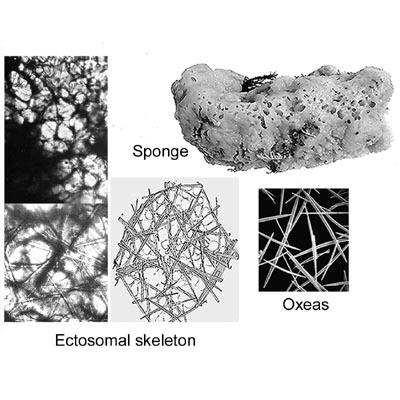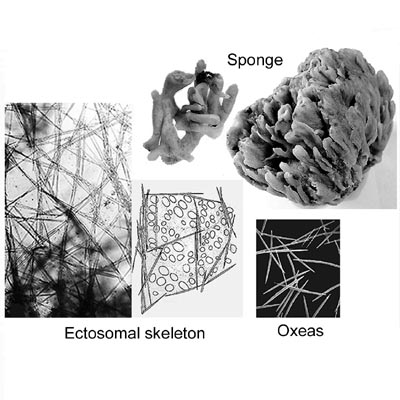On open coast.
Surface with regular reticulation of multispicular tracts.
Surface opaque.
Pores closely spaced in areas between tracts.
Oscula borne on ridges. |
 (Pallas, 1766)
(Pallas, 1766) |
Sponge:
Encrusting, sometimes more massive.
Oscula: with rows of oscules borne on ridges.
Color: Alive: Chrome yellow, yellow-tan, and, in well-lighted situations, olive or green at surface.
Spicules: Megascleres:
(1) Oxeas:
160 -313- 420 um.
x 1 -5- 12 um.
Warning: Undefined array key 4 in /home/thackerdb2/public_html/casponges/programfiles/WCS_Key4.php on line 129
Warning: Undefined array key 1 in /home/thackerdb2/public_html/casponges/programfiles/WCS_Key4.php on line 131
Skeleton:
Typical halichondriid structure, irregular and indistinct meshwork formed of loose bundles of spicules and of individual spicules mixed with occasional tracts.
Distribution: Southern to Northern California.
Depth: Intertidal to deep water, 113 m, the latter reported by Bakus & Green, 1987. On open coast..
Note:May be represented by a number of closely related species. These two species difficult to separate. See page 80 for further comparisons between these species.
|
|
In bays/harbors.
Surface with more widely spaced multispicular tracts tending to run parallel to one another. The areas between the tracts are further subdivided by a pattern of overlapping individual spicules.
Surface translucent or nearly so.
Pores more widely spaced.
Oscula scattered.
|
 Burton, 1930
Burton, 1930 |
Sponge:
Encrusting or, more often, branching or in flattened lobes.
Fatal error: Uncaught Error: Undefined constant "BOscules" in /home/thackerdb2/public_html/casponges/programfiles/WCS_Key4.php:300
Stack trace:
#0 {main}
thrown in /home/thackerdb2/public_html/casponges/programfiles/WCS_Key4.php on line 300
| |